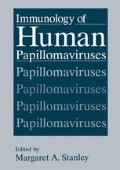Abstract
There is a growing evidence that immunological. system is involved in surveillance against HPV-associated neoplasia.1 The immune mechanisms responsible for eradication of HPV-induced tumors may include direct participation of natural. killer (NK) cells,2 activated macrophages,3 and cytotoxic T lymphocytes.4Furthermore, growth and dissemination of potentially malignant lesions may be under control of locally released im-munoregulatory anti-tumor cytokines including interferons,5 inter Ieukin-6, transforming growth factor-β,7 as well as tumor necrosis factor-α (TNF-α).8
Access this chapter
Tax calculation will be finalised at checkout
Purchases are for personal use only
Preview
Unable to display preview. Download preview PDF.
References
S. Jablonska, S. Majewski, and J. Malejczyk, Die Immunologie von HPV-Infektionen und der Mechanismus einer latenten Infektion, Hautarzt 43:305 (1992).
J. Malejczyk, S. Majewski, S. Jablonska, T.T. Rogozinski, and G. Orth, Abrogated NK-cell lysis of human papillomavirus (HPV)-16-bearing keratinocytes in patients with pre-cancerous and cancerous HPV-induced anogenital. lesions, Int. J. Cancer 43:209 (1989).
L. Banks, F. Moreau, K. Voudsen, D. Pirn, and G. Matlashewski, Expression of the human papillomavirus E7 oncogene during cell transformation is sufficient to induce susceptibility to lysis by activated macrophages. J. Immunol. 146:2037 (1991).
L. Chen, M.T. Mizuno, M.C. Singhal., S.-L. Hu, D.A. Galloway, I. Hellström, and K.E. Hellström, Induction of cytotoxic T lymphocytes specific for a syngeneic tumor expressing E6 oncoprotein of human papillomavirus type 16, J. Immunol. 148:2617 (1992).
K.F. Trofatter, Interferon treatment of anogenital. human papillomavirus-related diseases. Dermatol Clin. 9:343 (1991).
J. Malejczyk, M. Malejczyk, A. Urbanski, A. Köck, S. Jablonska, G. Orth, and T.A. Luger, Constitutive release of IL-6 by human papillomavirus type 16 (HPV16)-harboring keratinocytes: a mechanism augmenting the NK-cell-mediated lysis of HPV-bearing cells. Cell. Immunol. 136:155 (1991).
C.D. Woodworth, V. Notario, and J.A. DiPaolo, Transforming growth factors beta 1 and 2 transcriptionally regulate human papillomavirus (HPV) type 16 early gene expression in HPV-immortalized human genital. epithelial. cells. J. Virol. 64:4767 (1990).
J. Malejczyk, M. Malejczyk, A. Köck, A. Urbanski, S. Majewski, N. Hunzelmann, S. Jablonska, G. Orth, and T.A. Luger, Autocrine growth limitation of human papillomavirus type 16-harboring keratinocytes by constitutively released tumor necrosis factor-α. J. Immunol. 149:2702 (1992).
B. Beutler and A. Cerami, The biology of cachectin/TNF — a primary mediator of the host response, Ann. Rev. Immunol. 7:625 (1989).
S. Majewski, M. Skopinska, M. Malejczyk, F. Breitburd, G. Orth, S. Jablonska, and J. Malejczyk, Spontaneous expression of intercellular adhesion molecule 1 and tumorigenic progression of human papillomavirus type 16-harboring keratinocytes: a relationship to autocrine regulation by tumor necrosis factor α, Submitted for publication.
J. Malejczyk, M. Malejczyk, S. Majewski, F. Breitburd, T.A. Luger, S. Jablonska, and G. Orth, Increased tumorigenicity of human papillomavirus type 16-harboring keratinocytes is associated with resistance to endogenous tumor necrosis factor-α-mediated growth limitation, Int. J. Cancer, in press.
J. Malejczyk, M. Malejczyk, F. Breitburd, S. Majewski, A. Urbanski, N. Expert-Besançon, S. Jablonska, G. Orth, and T.A. Luger, Progressive growth of human papillomavirus type 16-harboring keratinocytes is associated with spontaneous release of soluble TNF-α receptor/TNF-α inhibitor. Submitted for publication.
S. Schneider-Maunoury, O. Croissant, and G. Orth, Integration of human papillomavirus type 16 DNA sequences: a possible early event in the progression of genital. tumors. J. Virol. 61:3295 (1987).
S. Schneider-Maunoury, G. Pehau-Arnaudet, F. Breitburd, and G. Orth, Expression of the human papillomavirus type 16 genome in SK-v cells, à line derived from vulvar intraepithelial. neoplasia. J. Gen. Virol. 71:809 (1990).
U. Trefzer, M. Brockhaus, H. Loetscher, F. Parlow, A. Kapp, E. Schöpf, and J. Krutmann, 55-kd tumor necrosis factor receptor is expressed by human keratinocytes and plays a pivotal. role in regulation of human keratinocyte ICAM-1 expression, J. Invest. Dermatol. 97:911 (1991).
D. Aderka, H. Engelmann, V. Wernik, Y. Skornick, Y. Levo, D. Wallach, and G. Kushtal, Increased serum levels of soluble receptors for tumor necrosis factor in cancer patients, Cancer Res. 51:5602 (1991).
S. Majewski, N. Hunzelmann, R. Nischt, B. Eckes, L. Rudnicka, G. Orth, T. Krieg, and S. Jablonska, TGFß-1 and TNFα expression in the epidermis of patients with epidermodysplasia verruciformis, J. Invest. Dermatol. 97:862 (1991).
Author information
Authors and Affiliations
Editor information
Editors and Affiliations
Rights and permissions
Copyright information
© 1994 Springer Science+Business Media New York
About this chapter
Cite this chapter
Malejczyk, J. et al. (1994). Release of Soluble Tumor Necrosis Factor-α (TNF-α) Receptor by HPV-Associated Neoplastic Cells. In: Stanley, M.A. (eds) Immunology of Human Papillomaviruses. Springer, Boston, MA. https://doi.org/10.1007/978-1-4615-2449-6_49
Download citation
DOI: https://doi.org/10.1007/978-1-4615-2449-6_49
Publisher Name: Springer, Boston, MA
Print ISBN: 978-1-4613-6041-4
Online ISBN: 978-1-4615-2449-6
eBook Packages: Springer Book Archive

